

Look for the waning moon to swing by the planets Jupiter and Mars on the mornings of February 7, 8 and 9. Read more.
Three of the five bright planets – Mars, Jupiter and Saturn – can be seen in the February 2018 for several hours before sunrise. Starting the second week of February, let the waning moon help guide your eye to Jupiter around February 7, Mars around February 9 and Saturn around February 11. The other two bright planets – Mercury and Venus – are essentially lost in the sun’s glare this month. Follow the links below to learn more about the planets in February 2018.
Venus low in the west after sunset
Mars east of Jupiter in predawn sky
Saturn east of Mars in predawn sky
Mercury shifts over to evening sky
EarthSky’s 2018 lunar calendars are here! Get yours while they last.
Like what EarthSky offers? Sign up for our free daily newsletter today!
Astronomy events, star parties, festivals, workshops
Visit a new EarthSky feature – Best Places to Stargaze – and add your fav.

You won’t see the moon with Venus in January 2018. This photo is from November 2017 – when the crescent moon made a triangle with Jupiter (top) and Venus before dawn. Photo taken over Valletta Lighthouse from Tigné Point on the island of Malta, by Gilbert Vancell Nature Photography.
Venus low in the west after sunset. Venus ranks as the third-brightest celestial body to light up our sky, after the sun and moon. Last month, in January 2018, this planet was out of view as it moved from the morning to evening sky. Venus, though nominally an evening “star” in February 2018, will hover so close to the sunset glare that it’ll be hard to see, even with binoculars.
You might have to wait until March 2018 to catch Venus in the west after sunset. At mid-northern latitudes, Venus sets less than one-half hour after the sun in early February and about one hour after the sun by the month’s end. At more southerly latitudes, Venus sets even sooner after sunset and is even harder to see. Click here for a sky almanac giving you the setting time for Venus in your sky.
From the Northern Hemisphere, Venus should become fairly easy to spot with the eye alone by mid-March 2018. Moreover, Venus’ close proximity to Mercury on the sky’s dome will enable northerly sky viewers to view Mercury, the innermost planet, for several weeks in March. Circle March 18 on your calendar, for that’s when the young lunar crescent will join up with Venus and Mercury at evening dusk and nightfall.

You might not see Venus or Mercury at all in February 2018. But try your luck on and around March 18, when the young moon meets up with these two worlds. Read more.
Did you see the spectacular conjunction of Venus and Jupiter in the morning sky on or around November 13, 2017? If not, check out these photos. Since the conjunction, Jupiter had been climbing away from the glare of sunrise day by day while Venus had been falling toward the sunrise daily. Throughout January 2018, Venus remained totally lost in the sun’s glare, as Venus made its transition out of the morning sky and into the evening sky.

Conjunction of Venus and Jupiter over downtown Denver on November 13, after emerging from the clouds, via Christy Sanchez. Venus is the brighter object.
Venus reached a milestone as the morning “star” when it swung out to its greatest elongation from the sun on June 3, 2017. At this juncture, Venus was farthest from the sun on our sky’s dome, and a telescope showed Venus as half-illuminated in sunshine, like a first quarter moon. For the rest of 2017, Venus was waxing toward full phase.
Why a half Venus? Why a full Venus? It’s all about the angle at which we see Venus with respect to the sun. When we view Venus to one side of the sun – as we did when it was at its greatest elongation in June – then we see it as half illuminated. That is, we’re seeing half of Venus’ lighted half (a quarter Venus). In January 2018, Venus swung behind the sun (at superior conjunction) as seen from Earth, and a nearly-full Venus now occupies the February 2018 evening sky.
Click here to know Venus’s exact phase at present, remembering to select Venus as your object of interest.
The chart below helps to illustrate why we sometimes see Venus in the evening, and sometimes before dawn.

The Earth and Venus orbit the sun counterclockwise as seen from earthly north. When Venus is to the east (left) of the Earth-sun line, we see Venus as an evening “star” in the west after sunset. After Venus reaches its inferior conjunction, Venus then moves to the west (right) of the Earth-sun line, appearing as a morning “star” in the east before sunrise.

Let the last quarter moon help guide your eye to the planet Jupiter in the February 7th predawn and dawn sky. Read more.
Jupiter lights up predawn sky. Because Venus is virtually lost in the sun’s glare this month, the king planet Jupiter takes over as the brightest starlike object to grace the nighttime sky. Jupiter beams during the predawn hours (and morning dawn, too!) all month long.
This month, Jupiter shines in front of the constellation Libra the Scales and close to Libra’s alpha star, Zubenelgenubi. Use brilliant Jupiter to locate Zubenelgenubi, and then use binoculars to view this star as a double star!
Before dawn, look for modesty-bright Mars to the east of Jupiter. Watch the gap between Jupiter and the red planet Mars grow throughout the month. Jupiter stays in front of the constellation Libra the Scales all month long, whereas Mars moves out of the constellation Scorpius to enter the constellation Ophiuchus at the beginning of the second week of February 2018.
Be sure to watch for the last quarter moon in the vicinity of Jupiter on February 7.
From mid-northern latitudes, Jupiter rises better than an hour after midnight (approximately 1 to 2 a.m. local time) in early February. By the month’s end, Jupiter comes up around midnight local time.
From temperate latitudes in the Southern Hemisphere, Jupiter rises at or near the midnight hour local time in early February; and by the month’s end, Jupiter rises about two hours before local midnight (roughly 10 p.m.)
Click here for an almanac telling you Jupiter’s rising time in your sky.
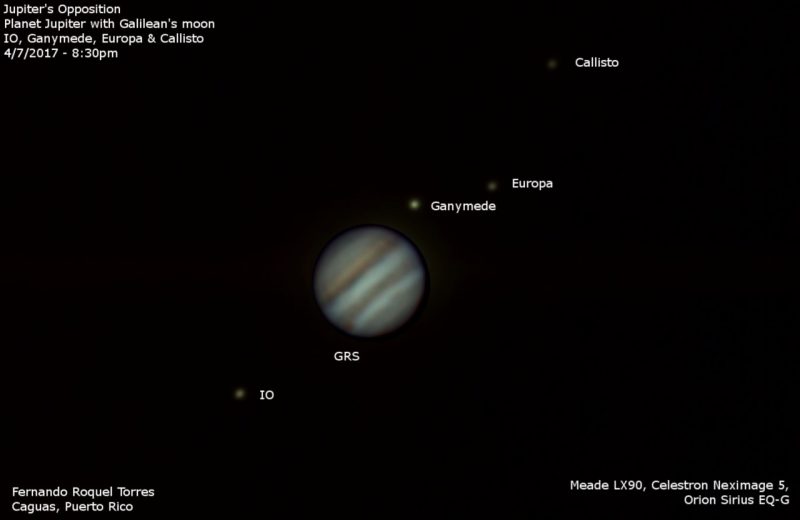
Fernando Roquel Torres in Caguas, Puerto Rico captured Jupiter, the Great Red Spot (GRS) and all 4 of its largest moons – the Galilean satellites – on the date of Jupiter’s 2017 opposition (April 7).
If you have binoculars or a telescope, it’s fairly easy to see Jupiter’s four major moons, which look like pinpricks of light all on or near the same plane. They are often called the Galilean moons to honor Galileo, who discovered these great Jovian moons in 1610. In their order from Jupiter, these moons are Io, Europa, Ganymede and Callisto.
These moons orbit Jupiter around the Jovian equator. In cycles of six years, we view Jupiter’s equator edge-on. So, in 2015, we were able to view a number of mutual events involving Jupiter’s moons, through high-powered telescopes. Starting in late 2016, Jupiter’s axis began tilting enough toward the sun and Earth so that the farthest of these four moons, Callisto, has not been passing in front of Jupiter or behind Jupiter, as seen from our vantage point. This will continue for a period of about three years, during which time Callisto is perpetually visible to those with telescopes, alternately swinging above and below Jupiter as seen from Earth.
Click here for a Jupiter’s moons almanac, courtesy of skyandtelescope.com.
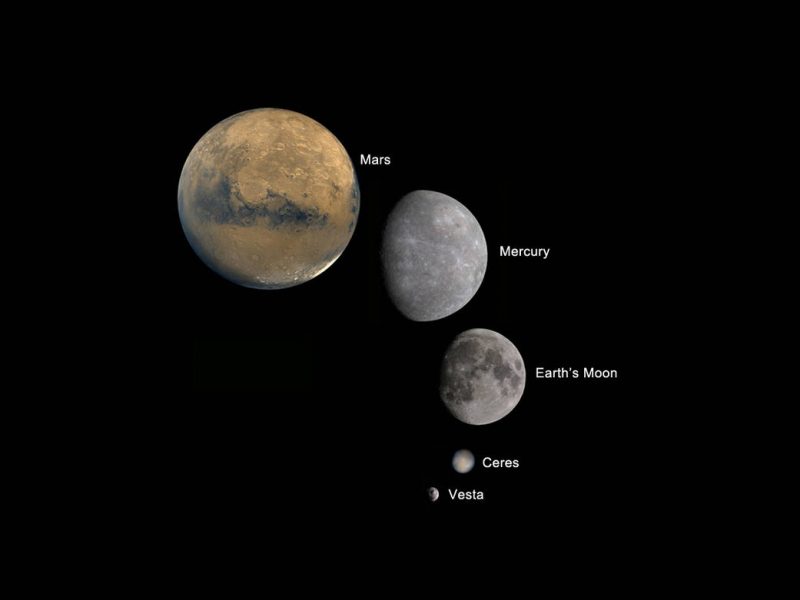
Mars, Mercury, Earth’s moon and the dwarf planet Ceres. Mars is smaller than Earth, but bigger than our moon. Image via NASA/JPL-Caltech/UCLA.

Look for the waning moon to swing by the planet Mars on the morning of February 9. Read more.
Mars east of Jupiter in predawn sky. Look for Mars (and Jupiter) to rise in the east several hours before the first stirrings of morning twilight. Modestly-bright Mars starts off the month fairly close to to the dazzling king planet Jupiter. Mars lodges at the border of the constellations Libra and Scorpius in early February and then moves into the constellation Ophiuchus during the second week of February 2018.
Although Mars will attain 1st-magnitude brightness by around mid-February, it will still look pale next to Jupiter, the brightest starlike object in the nighttime sky. Shining at a magnitude of -2, Jupiter will be some 16 times brighter than the red planet in middle February.
Very conveniently, Mars shines in the neighborhood of the 1st-magnitude red star Antares all month long. Be sure to compare and contrast the brilliance and color of these two celestial gems in the predawn morning sky. Mars brightens throughout the month, and by the month’s end, will probably outshine Antares. However, the precise magnitude of Mars isn’t altogether predictable because of the possibility of dust storms.
By the end of the month, Mars will have moved closer to the ringed planet Saturn and farther away from Jupiter. Mars will finally catch up with Saturn in early April, to stage a close conjunction on April 2, 2018. By that time, Mars is expected to beam some 3 times brighter than Antares and twice as bright as Saturn. What’s more, Mars will be 3 times brighter in early April than its former fainter self in mid-February.
It’s best to look for Mars and Antares before dawn (approximately one and one-half hours before sunrise) because these ruddy gems appear rather meek in the glow of morning twilight.
Let the waning crescent moon help guide your eye to Mars (and Jupiter) for several mornings, centered on February 9.
Exactly one year after Mars’s superior conjunction on July 27, 2017, Mars will swing to opposition on July 27, 2018. This will be Mars’s best opposition since its historically close opposition on August 28, 2003. In fact, Mars will become the fourth-brightest heavenly body to light up the sky in July 2018, after the sun, moon and the planet Venus. It’s not often that Mars outshines Jupiter, normally the fourth-brightest celestial body.
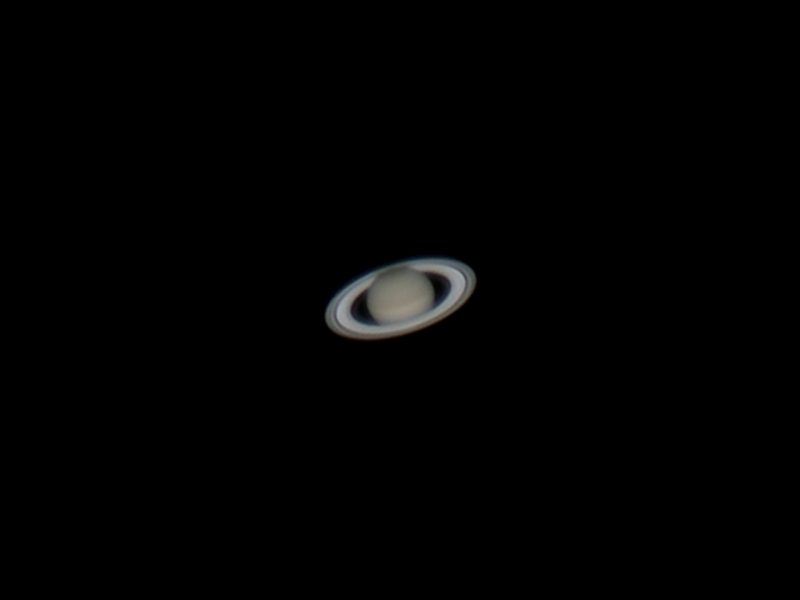
James Martin in Albuquerque, New Mexico caught this wonderful photo of Saturn on its June 15, 2017 opposition.
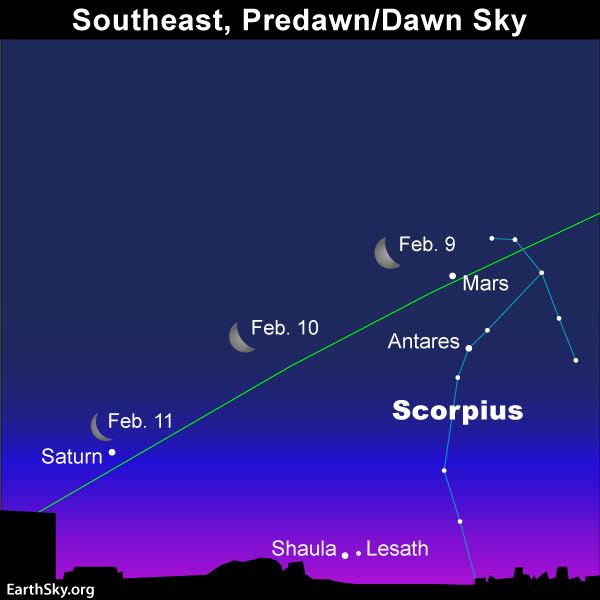
The waning crescent moon swings 2o (4 moon-diameters) north of Saturn on February 9. Read more.
Saturn east of Mars in predawn sky. Saturn, the farthest world that you can easily view with the eye alone, appears golden in color. It shines with a steady light. The waning crescent moon helps guide your eye to Saturn (plus Mars and Jupiter) for several mornings, starting on or around January 7. To cap things off, look for the moon to pass some 2o (4 moon-diameters) north of Saturn on February 11.
From mid-northern latitudes (US and Europe), Saturn rises about two hours before sunrise in early February (roughly 5 a.m. local time). By the month’s end, look for Saturn to rise about 3 hours before the sun (around 3 to 4 a.m. local time).
From temperate latitudes in the Southern Hemisphere (South Africa, southern Australia), Saturn rises about 3 hours before sunrise in early February (approximately 3 a.m. local time); and by the month’s end, the ringed planet comes up about one hour after local midnight.
Click here for recommended almanacs; they can help you know when the planets rise, transit and set in your sky.
Binoculars don’t reveal Saturn’s gorgeous rings, by the way, although binoculars will enhance Saturn’s color. To see the rings, you need a small telescope. A telescope will also reveal one or more of Saturn’s many moons, most notably Titan.
Saturn’s rings are now inclined at about 26o from edge-on, exhibiting their northern face. In 2017, the north side of the rings opened up most widely (27o) since since the last grand opening in 1988. The next maximum exposure of the north side of Saturn’s rings will take place in 2046.
As with so much in space (and on Earth), the appearance of Saturn’s rings from Earth is cyclical. In the year 2025, the rings will appear edge-on as seen from Earth. After that, we’ll begin to see the south side of Saturn’s rings, to increase to a maximum inclination of 27o by May 2032.
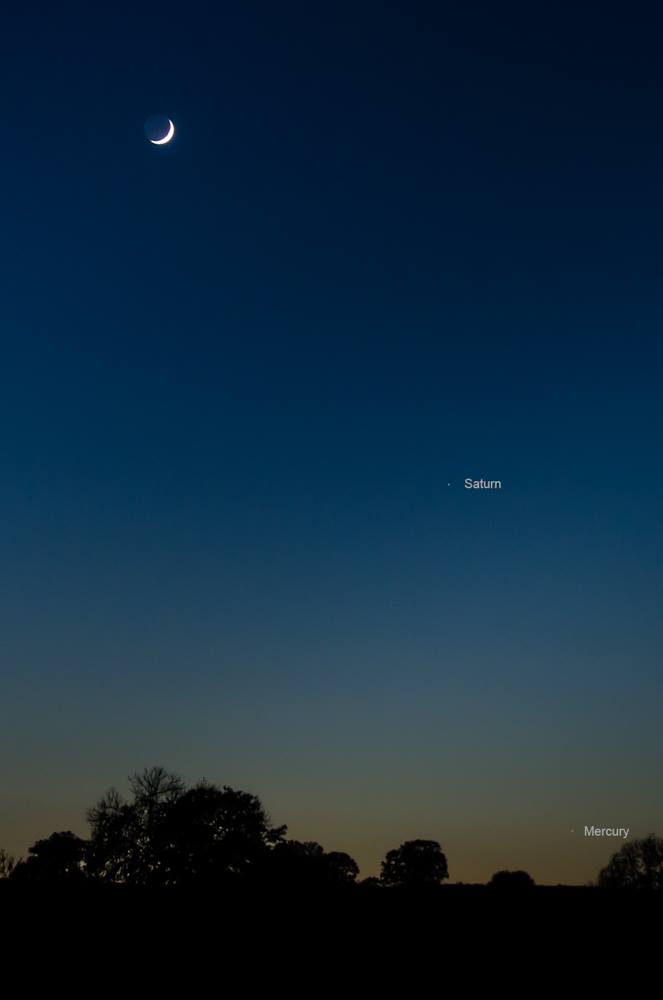
November 21, 2017 photo of the waxing crescent moon, Saturn and Mercury in the evening sky via Annie Lewis in Madrid, Spain.
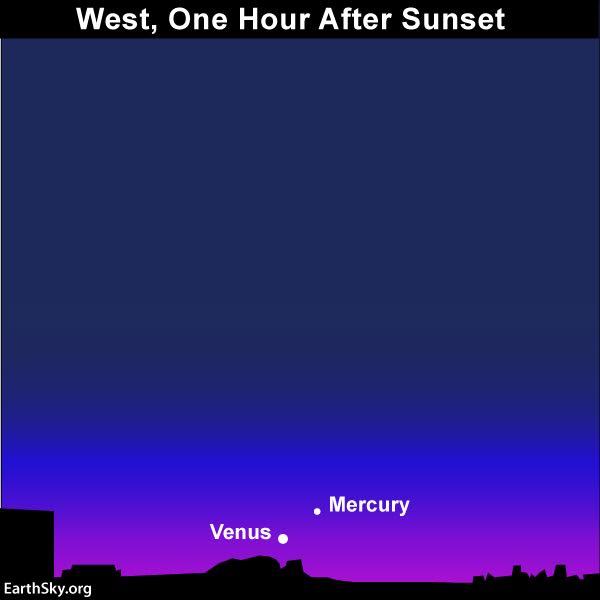
Mid-March 2018 will present a great time for using Venus to spot Mercury in the western sky after sunset. Read more.
Mercury shifts over to evening sky. This month, Mercury swings to superior conjunction on February 17, 2018, thereby transitioning out of the morning sky and into the evening sky. However, Mercury will set soon after the sun and probably won’t be seen low in the western evening dusk until March 2018.
The good news is that this upcoming evening apparition of Mercury in March will be the best of the year for the Northern Hemisphere (yet the poorest for the Southern Hemisphere). Moreover, the brilliant planet Venus will shine close Mercury for several weeks, enabling sky watchers to use Venus (and if need be, binoculars) to find Mercury.
Intrepid sky watchers might catch Mercury as soon as late February or early March, at which time Mercury will be setting about 45 to 50 minutes after sun (at mid-northern latitudes). But the best viewing will come around mid-March, when Mercury stays out for a whopping 90 minutes after sunset. Stayed tuned!
Mercury is tricky, even when it becomes visible. If you look too early, Mercury will be obscured by evening twilight; if you look too late, it will be beneath the horizon. When March comes rolling along, watch for Mercury low in the sky, and near the sunset point on the horizon, being mindful of Mercury’s setting time.
Use the the waxing crescent moon to find Mercury pairing up with Venus on the evenings of March 18, 19 and 20.
What do we mean by bright planet? By bright planet, we mean any solar system planet that is easily visible without an optical aid and that has been watched by our ancestors since time immemorial. In their outward order from the sun, the five bright planets are Mercury, Venus, Mars, Jupiter and Saturn. These planets actually do appear bright in our sky. They are typically as bright as – or brighter than – the brightest stars. Plus, these relatively nearby worlds tend to shine with a steadier light than the distant, twinkling stars. You can spot them, and come to know them as faithful friends, if you try.
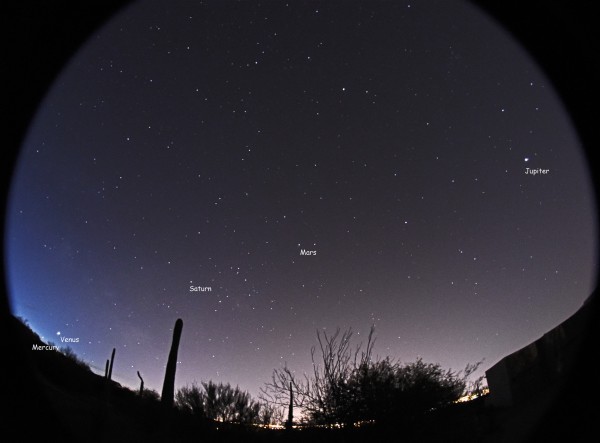
This image is from February 8, 2016. It shows all 5 bright planets at once. Photo by our friend Eliot Herman in Tucson, Arizona.

Skywatcher, by Predrag Agatonovic.
Bottom line: In February 2018, three of the five bright planets – Mars, Jupiter and Saturn – adorn the predawn sky. Meanwhile, Mercury and Venus are lost in the sun’s glare.
Don’t miss anything. Subscribe to EarthSky News by email
Enjoy knowing where to look in the night sky? Please donate to help EarthSky keep going.
from EarthSky http://ift.tt/IJfHCr


Look for the waning moon to swing by the planets Jupiter and Mars on the mornings of February 7, 8 and 9. Read more.
Three of the five bright planets – Mars, Jupiter and Saturn – can be seen in the February 2018 for several hours before sunrise. Starting the second week of February, let the waning moon help guide your eye to Jupiter around February 7, Mars around February 9 and Saturn around February 11. The other two bright planets – Mercury and Venus – are essentially lost in the sun’s glare this month. Follow the links below to learn more about the planets in February 2018.
Venus low in the west after sunset
Mars east of Jupiter in predawn sky
Saturn east of Mars in predawn sky
Mercury shifts over to evening sky
EarthSky’s 2018 lunar calendars are here! Get yours while they last.
Like what EarthSky offers? Sign up for our free daily newsletter today!
Astronomy events, star parties, festivals, workshops
Visit a new EarthSky feature – Best Places to Stargaze – and add your fav.

You won’t see the moon with Venus in January 2018. This photo is from November 2017 – when the crescent moon made a triangle with Jupiter (top) and Venus before dawn. Photo taken over Valletta Lighthouse from Tigné Point on the island of Malta, by Gilbert Vancell Nature Photography.
Venus low in the west after sunset. Venus ranks as the third-brightest celestial body to light up our sky, after the sun and moon. Last month, in January 2018, this planet was out of view as it moved from the morning to evening sky. Venus, though nominally an evening “star” in February 2018, will hover so close to the sunset glare that it’ll be hard to see, even with binoculars.
You might have to wait until March 2018 to catch Venus in the west after sunset. At mid-northern latitudes, Venus sets less than one-half hour after the sun in early February and about one hour after the sun by the month’s end. At more southerly latitudes, Venus sets even sooner after sunset and is even harder to see. Click here for a sky almanac giving you the setting time for Venus in your sky.
From the Northern Hemisphere, Venus should become fairly easy to spot with the eye alone by mid-March 2018. Moreover, Venus’ close proximity to Mercury on the sky’s dome will enable northerly sky viewers to view Mercury, the innermost planet, for several weeks in March. Circle March 18 on your calendar, for that’s when the young lunar crescent will join up with Venus and Mercury at evening dusk and nightfall.

You might not see Venus or Mercury at all in February 2018. But try your luck on and around March 18, when the young moon meets up with these two worlds. Read more.
Did you see the spectacular conjunction of Venus and Jupiter in the morning sky on or around November 13, 2017? If not, check out these photos. Since the conjunction, Jupiter had been climbing away from the glare of sunrise day by day while Venus had been falling toward the sunrise daily. Throughout January 2018, Venus remained totally lost in the sun’s glare, as Venus made its transition out of the morning sky and into the evening sky.

Conjunction of Venus and Jupiter over downtown Denver on November 13, after emerging from the clouds, via Christy Sanchez. Venus is the brighter object.
Venus reached a milestone as the morning “star” when it swung out to its greatest elongation from the sun on June 3, 2017. At this juncture, Venus was farthest from the sun on our sky’s dome, and a telescope showed Venus as half-illuminated in sunshine, like a first quarter moon. For the rest of 2017, Venus was waxing toward full phase.
Why a half Venus? Why a full Venus? It’s all about the angle at which we see Venus with respect to the sun. When we view Venus to one side of the sun – as we did when it was at its greatest elongation in June – then we see it as half illuminated. That is, we’re seeing half of Venus’ lighted half (a quarter Venus). In January 2018, Venus swung behind the sun (at superior conjunction) as seen from Earth, and a nearly-full Venus now occupies the February 2018 evening sky.
Click here to know Venus’s exact phase at present, remembering to select Venus as your object of interest.
The chart below helps to illustrate why we sometimes see Venus in the evening, and sometimes before dawn.

The Earth and Venus orbit the sun counterclockwise as seen from earthly north. When Venus is to the east (left) of the Earth-sun line, we see Venus as an evening “star” in the west after sunset. After Venus reaches its inferior conjunction, Venus then moves to the west (right) of the Earth-sun line, appearing as a morning “star” in the east before sunrise.

Let the last quarter moon help guide your eye to the planet Jupiter in the February 7th predawn and dawn sky. Read more.
Jupiter lights up predawn sky. Because Venus is virtually lost in the sun’s glare this month, the king planet Jupiter takes over as the brightest starlike object to grace the nighttime sky. Jupiter beams during the predawn hours (and morning dawn, too!) all month long.
This month, Jupiter shines in front of the constellation Libra the Scales and close to Libra’s alpha star, Zubenelgenubi. Use brilliant Jupiter to locate Zubenelgenubi, and then use binoculars to view this star as a double star!
Before dawn, look for modesty-bright Mars to the east of Jupiter. Watch the gap between Jupiter and the red planet Mars grow throughout the month. Jupiter stays in front of the constellation Libra the Scales all month long, whereas Mars moves out of the constellation Scorpius to enter the constellation Ophiuchus at the beginning of the second week of February 2018.
Be sure to watch for the last quarter moon in the vicinity of Jupiter on February 7.
From mid-northern latitudes, Jupiter rises better than an hour after midnight (approximately 1 to 2 a.m. local time) in early February. By the month’s end, Jupiter comes up around midnight local time.
From temperate latitudes in the Southern Hemisphere, Jupiter rises at or near the midnight hour local time in early February; and by the month’s end, Jupiter rises about two hours before local midnight (roughly 10 p.m.)
Click here for an almanac telling you Jupiter’s rising time in your sky.

Fernando Roquel Torres in Caguas, Puerto Rico captured Jupiter, the Great Red Spot (GRS) and all 4 of its largest moons – the Galilean satellites – on the date of Jupiter’s 2017 opposition (April 7).
If you have binoculars or a telescope, it’s fairly easy to see Jupiter’s four major moons, which look like pinpricks of light all on or near the same plane. They are often called the Galilean moons to honor Galileo, who discovered these great Jovian moons in 1610. In their order from Jupiter, these moons are Io, Europa, Ganymede and Callisto.
These moons orbit Jupiter around the Jovian equator. In cycles of six years, we view Jupiter’s equator edge-on. So, in 2015, we were able to view a number of mutual events involving Jupiter’s moons, through high-powered telescopes. Starting in late 2016, Jupiter’s axis began tilting enough toward the sun and Earth so that the farthest of these four moons, Callisto, has not been passing in front of Jupiter or behind Jupiter, as seen from our vantage point. This will continue for a period of about three years, during which time Callisto is perpetually visible to those with telescopes, alternately swinging above and below Jupiter as seen from Earth.
Click here for a Jupiter’s moons almanac, courtesy of skyandtelescope.com.

Mars, Mercury, Earth’s moon and the dwarf planet Ceres. Mars is smaller than Earth, but bigger than our moon. Image via NASA/JPL-Caltech/UCLA.

Look for the waning moon to swing by the planet Mars on the morning of February 9. Read more.
Mars east of Jupiter in predawn sky. Look for Mars (and Jupiter) to rise in the east several hours before the first stirrings of morning twilight. Modestly-bright Mars starts off the month fairly close to to the dazzling king planet Jupiter. Mars lodges at the border of the constellations Libra and Scorpius in early February and then moves into the constellation Ophiuchus during the second week of February 2018.
Although Mars will attain 1st-magnitude brightness by around mid-February, it will still look pale next to Jupiter, the brightest starlike object in the nighttime sky. Shining at a magnitude of -2, Jupiter will be some 16 times brighter than the red planet in middle February.
Very conveniently, Mars shines in the neighborhood of the 1st-magnitude red star Antares all month long. Be sure to compare and contrast the brilliance and color of these two celestial gems in the predawn morning sky. Mars brightens throughout the month, and by the month’s end, will probably outshine Antares. However, the precise magnitude of Mars isn’t altogether predictable because of the possibility of dust storms.
By the end of the month, Mars will have moved closer to the ringed planet Saturn and farther away from Jupiter. Mars will finally catch up with Saturn in early April, to stage a close conjunction on April 2, 2018. By that time, Mars is expected to beam some 3 times brighter than Antares and twice as bright as Saturn. What’s more, Mars will be 3 times brighter in early April than its former fainter self in mid-February.
It’s best to look for Mars and Antares before dawn (approximately one and one-half hours before sunrise) because these ruddy gems appear rather meek in the glow of morning twilight.
Let the waning crescent moon help guide your eye to Mars (and Jupiter) for several mornings, centered on February 9.
Exactly one year after Mars’s superior conjunction on July 27, 2017, Mars will swing to opposition on July 27, 2018. This will be Mars’s best opposition since its historically close opposition on August 28, 2003. In fact, Mars will become the fourth-brightest heavenly body to light up the sky in July 2018, after the sun, moon and the planet Venus. It’s not often that Mars outshines Jupiter, normally the fourth-brightest celestial body.

James Martin in Albuquerque, New Mexico caught this wonderful photo of Saturn on its June 15, 2017 opposition.

The waning crescent moon swings 2o (4 moon-diameters) north of Saturn on February 9. Read more.
Saturn east of Mars in predawn sky. Saturn, the farthest world that you can easily view with the eye alone, appears golden in color. It shines with a steady light. The waning crescent moon helps guide your eye to Saturn (plus Mars and Jupiter) for several mornings, starting on or around January 7. To cap things off, look for the moon to pass some 2o (4 moon-diameters) north of Saturn on February 11.
From mid-northern latitudes (US and Europe), Saturn rises about two hours before sunrise in early February (roughly 5 a.m. local time). By the month’s end, look for Saturn to rise about 3 hours before the sun (around 3 to 4 a.m. local time).
From temperate latitudes in the Southern Hemisphere (South Africa, southern Australia), Saturn rises about 3 hours before sunrise in early February (approximately 3 a.m. local time); and by the month’s end, the ringed planet comes up about one hour after local midnight.
Click here for recommended almanacs; they can help you know when the planets rise, transit and set in your sky.
Binoculars don’t reveal Saturn’s gorgeous rings, by the way, although binoculars will enhance Saturn’s color. To see the rings, you need a small telescope. A telescope will also reveal one or more of Saturn’s many moons, most notably Titan.
Saturn’s rings are now inclined at about 26o from edge-on, exhibiting their northern face. In 2017, the north side of the rings opened up most widely (27o) since since the last grand opening in 1988. The next maximum exposure of the north side of Saturn’s rings will take place in 2046.
As with so much in space (and on Earth), the appearance of Saturn’s rings from Earth is cyclical. In the year 2025, the rings will appear edge-on as seen from Earth. After that, we’ll begin to see the south side of Saturn’s rings, to increase to a maximum inclination of 27o by May 2032.

November 21, 2017 photo of the waxing crescent moon, Saturn and Mercury in the evening sky via Annie Lewis in Madrid, Spain.

Mid-March 2018 will present a great time for using Venus to spot Mercury in the western sky after sunset. Read more.
Mercury shifts over to evening sky. This month, Mercury swings to superior conjunction on February 17, 2018, thereby transitioning out of the morning sky and into the evening sky. However, Mercury will set soon after the sun and probably won’t be seen low in the western evening dusk until March 2018.
The good news is that this upcoming evening apparition of Mercury in March will be the best of the year for the Northern Hemisphere (yet the poorest for the Southern Hemisphere). Moreover, the brilliant planet Venus will shine close Mercury for several weeks, enabling sky watchers to use Venus (and if need be, binoculars) to find Mercury.
Intrepid sky watchers might catch Mercury as soon as late February or early March, at which time Mercury will be setting about 45 to 50 minutes after sun (at mid-northern latitudes). But the best viewing will come around mid-March, when Mercury stays out for a whopping 90 minutes after sunset. Stayed tuned!
Mercury is tricky, even when it becomes visible. If you look too early, Mercury will be obscured by evening twilight; if you look too late, it will be beneath the horizon. When March comes rolling along, watch for Mercury low in the sky, and near the sunset point on the horizon, being mindful of Mercury’s setting time.
Use the the waxing crescent moon to find Mercury pairing up with Venus on the evenings of March 18, 19 and 20.
What do we mean by bright planet? By bright planet, we mean any solar system planet that is easily visible without an optical aid and that has been watched by our ancestors since time immemorial. In their outward order from the sun, the five bright planets are Mercury, Venus, Mars, Jupiter and Saturn. These planets actually do appear bright in our sky. They are typically as bright as – or brighter than – the brightest stars. Plus, these relatively nearby worlds tend to shine with a steadier light than the distant, twinkling stars. You can spot them, and come to know them as faithful friends, if you try.

This image is from February 8, 2016. It shows all 5 bright planets at once. Photo by our friend Eliot Herman in Tucson, Arizona.

Skywatcher, by Predrag Agatonovic.
Bottom line: In February 2018, three of the five bright planets – Mars, Jupiter and Saturn – adorn the predawn sky. Meanwhile, Mercury and Venus are lost in the sun’s glare.
Don’t miss anything. Subscribe to EarthSky News by email
Enjoy knowing where to look in the night sky? Please donate to help EarthSky keep going.
from EarthSky http://ift.tt/IJfHCr

Aucun commentaire:
Enregistrer un commentaire